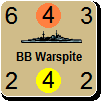The damage to Scharnhorst meant that she needed to be patched up as quickly as possible and returned to Germany for proper repair work. She finally sailed on the 20th June 1940. She was escorted by the destroyers Lody, Schoemann and Steinbrinck, the torpedo boats Kondor and Grief and three minesweepers.
Despite the losses incurred so far, the British continued to make attempts at sinking Scharnhorst. Firstly Swordfish from 821 and 823 Squadrons based at Hatston attacked on the 21st June. Their torpedoes were all successfully combed by the battleship and two Swordfish were lost. There was then another high level bombing attack from RAF Hudsons of 224 and 233 Squadrons but this too failed for the loss of 233's squadron leader.
The next attempt was by Beauforts of 42 Squadron. Three attackers were lost to the ever increasing enemy fighter cover before the final attempt of the day was made by Hudsons of 269 Squadron. This too failed, although this time without loss to the bombers. Poor weather kept the British from launching further attacks and Scharnhorst reached Germany on the 23rd June.
For Gneisenau the journey home was not quite to successful, although she still made it to Germany.
In company with Admiral Hipper and Galster, she set sail just before Scharnhorst. The three ships were off Kya Lighthouse when, at around 23:35hrs, a torpedo from the submarine HMS Clyde struck Gneisenau's port bow. The ships returned to Trondheim in order that damage could be properly assessed. Even makeshift repairs took far longer than expected, and it was not until almost a month had gone past, on the 19th July, that she was able to begin work up.
On the 25th July Gneisenau finally left her anchorage along with Hipper, Lody, Paul Jacobi, Galster and Friedrich Ihn. The heavy cruiser was detached and sailed for the Arctic (see post xxx). The remaining ships were joined by the light cruiser Nurnburg.
The only incident on the journey to Germany this time was the sinking of one of the torpedo boats sent out from Stavanger to meet the flotilla. Luchs and Iltis joined the south bound ships in the afternoon of the 26th. Three hours later, there was an explosion and Luchs broke in two and sank. It is unknown for certain whether she hit a mine or was stuck by a torpedo intended for the battleship. If it was a torpedo it would likely have come from HMS Thames (Clyde's sistership). We will never know because it was believed that Thames was lost with all hands around that time.
Gneisenau reached Germany on the 28th July.
The River-class submarine HMS Clyde. She survived the war having fought in Northern Europe, the Mediterranean and the Far East.

The Torpedo Boat Luchs. She was a Type 24 boat, built, along with her five sisters, between 1926 and 1929

Sources:
The Battle for Norway (Haarr)
All The World's Fighting Ships 1922-1946








